WWW Wednesday is a weekly meme hosted by Sam@Taking on a World of Words.
To play answer the three ‘W’ questions listed below. Be sure to link back to her or to put the link to your post in the comment section of her blog so that others take a gander at your answers and maybe find new reads to throw in their TBR mountain.
The Three W’s are:
What are you currently reading?
What did you recently finish reading?
What do you think you’ll read next?
What I’m Currently Reading
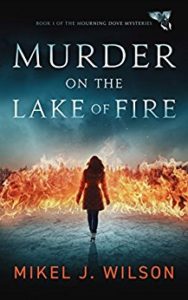
‘At twenty-three and with a notorious case under his belt, Emory Rome has already garnered fame as a talented special agent for the Tennessee Bureau of Investigation. His career is leapfrogging over his colleagues, but the jumping stops when he’s assigned a case he fought to avoid – an eerie murder in the Smoky Mountain hometown he had abandoned. The mysterious death of a teen ice-skater once destined for the pros is soon followed by an apparent case of spontaneous human combustion. In a small town bursting with friends and foes, Rome’s own secrets lie just beneath the surface. The rush to find the murderer before he strikes again pits him against artful private investigator Jeff Woodard. The PI is handsome, smart and seductive, and he just might be the killer Rome is seeking.’
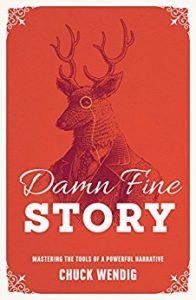
‘HOOK YOUR AUDIENCE WITH UNFORGETTABLE STORYTELLING
What do Luke Skywalker, John McClane, and a lonely dog on Ho‘okipa Beach have in common?
Simply put, we care about them.
Great storytelling is making readers care about your characters, the choices they make, and what happens to them. It’s making your audience feel the tension and emotion of a situation right alongside your protagonist. And to tell a damn fine story, you need to understand why and how that caring happens.
Using a mix of personal stories, pop fiction examples, and traditional storytelling terms, New York Times best-selling author Chuck Wendig will help you internalize the feel of powerful storytelling. In Damn Fine Story, you’ll explore:
Freytag’s Pyramid for visualizing story structure – and when to break away from traditional storytelling forms
Character relationships and interactions as the basis of every strong plot – no matter the form or genre
Rising and falling tension that pulls the audience through to the climax and conclusion of the story
Developing themes as a way to craft characters with depth
Whether you’re writing a novel, screenplay, video game, comic, or even if you just like to tell stories to your friends and family over dinner, this funny and informative guide is chock-full of examples about the art and craft of storytelling – and how to write a damn fine story of your own.‘

‘The Stories of Edgar Allan Poe is a brilliant collection of some of his best-known stories: The Tell Tale Heart (a murder’s haunting guilt), The Cask of Amontillado (a story of brilliant revenge), and The Fall of the House of Usher (an ancient house full of very dark secretes). Also included in this collection are The Mask of the Red Death (horrors of ‘the Plague’), and the most famous of all his poems: The Raven (a lover’s decline into madness). Best read in a dimly-lit room with the curtains drawn, Poe’s brilliant works come to life in darkly thrilling ways in this Manga Classic adaptation.’
What I Recently Finished

‘They say that sex is a lot like pizza: Even when it’s bad, it’s still pretty good. The difference is that no one wants to hear about your worst slice of pizza. But what about your most embarrassing, mortifying, and hilarious sexual escapades? Trade in the cheese for some sleaze, and people are all ears.
In We’re All Bad in Bed, award-winning author and unrepentant ragamuffin Shelby Simpson mines her past (and the past of her most trusted friends) for the ultimate bedroom debacles. From hitting puberty in small-town Oklahoma to traveling the world with a flask of vodka and a contagious smile, Shelby’s unique perspective on sexual education, intimacy, and doin’ the nasty is sure to please anyone who’s ever been caught with their pants around their knees.
Shelby’s highly entertaining and deliciously scandalous stories will have you pondering the word “blowjob” as the ultimate misnomer, whether the legend of the Killer Coochie could be more than just a legend, and the worst way to completely and utterly embarrass yourself sexually in front of the worst person imaginable. Inside these pages, there is no judgment. There is only uncensored and uncircumcised honesty.
This book is the most fun you can have with your pants on (or ditch the pants, your call). Take two parts hilarity, one part poignant self-reflection, bake it on a crust of gangsta rap and top it with a dollop of Southern twang, and you have a healthy helping of the juiciest and jauntiest nookie book of the year.
Dig in.
Pizza optional.’
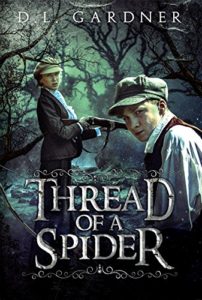
‘TEENS ENLIST THE FAE TO WIN A WAR IN IRELAND
When all attempts to save her fiance fail, Ailis must rely on the magic of the forest folk.
Following an ambush at the Upton Rail Station in 1921 Ireland, British troops burn Ailis’ home to the ground and arrest her fiancé, Liam, for murder. She and her younger brother Paddy flee to an enchanted glen. Lured by a haunting song, Paddy is abducted by forest folk. Perilous obstacles, and a questionable stranger, hinder Ailis’ attempts to find her brother or free her fiance, until her only hope for survival rests on the magic of the Fae.
˃˃˃ A bitter uprising in Ireland is taking place and two siblings are tossed in the battle, facing death, believing in love, and hoping in magic.
1920 found Ireland at the peak of tensions that had been building for centuries. Famine, tyranny and strife robbed the Irish of their homes, their lives and their country. Four years after the Easter Rising, pressure became so great, that the southern Irish took up arms against the British and fought for a free nation. Thread of a Spider, a historical fantasy, weaves history and Irish myth together to tell a story about two teenage siblings caught in the war and swathed in the legends of Erie.˃˃˃ A fantasy based on history woven with rich Irish lore.’
What I Hope to Read Next
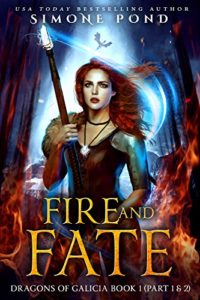
‘In Simone Pond’s captivating new fantasy series, Evelyn embraces her dragon slayer destiny to conquer an evil kingdom and kill every last dragon in Galicia.
Unknowing descendant of a legendary dragon slayer, Evelyn is convinced that getting out of her quaint hamlet is the answer to finding true love and happiness. But she seems destined to work on her mother’s farm, while the other girls present themselves before the gallant Prince Kieran in his quest to find a lady-in-waiting.
When the prince finally takes notice of Evelyn, he’s smitten and chooses her above all the others. Evelyn is elated about living in Verubri Castle and the possibility of marriage. But her happiness is quickly squelched when the prince invites Evelyn’s arch rival, Ciara, to join them.
Before traveling north, Evelyn discovers her dragon slayer ancestry, something she knows must be concealed from Prince Kieran who would consider it treason against his kingdom. But the only way to survive the treacherous journey is to expose herself and possibly ruin her future and even end her life.’
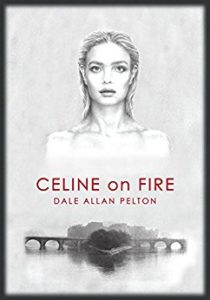
‘“Céline on Fire” poses the question, why read history? Set during the Cold War, “Céline” is a coming of age story in 1950s Paris. Céline Colbert, 14, a dancer, her sister Yvonne, 28, professor of philosophy and history at the Sorbonne, share a taxi in the rain with Giovanni Sandretti, 23, an Italian-American trumpet player born in Viterbo, Italy. In the Parisian worlds of jazz, flamenco, and tango, Giovanni becomes Yvonne’s lover and Céline’s friend. Each of the characters share the narration from chapter to chapter like a jazz trio swapping riffs as they improvise on a common theme. Bertrand Russell said, “To understand an age or a nation we must understand its philosophy, and to understand its philosophy we must ourselves be in some degree philosophers.” The lesson of “Céline on Fire” is that it is our responsibility for each of us to be that philosopher.
After a shattering tragedy, Céline struggles to find herself as both an artist and a woman. In a time when everyone went out dancing, and Parisians endlessly debated politics in the cafés, the novel recreates the era of Ginger Rogers and Fred Astaire, Cyd Charisse and Audrey Hepburn, with dance sequences of ballet, jazz, ballroom, Latin and tango, reprising the 1950’s musicals of Gene Kelly’s “American in Paris.” Haunted by heartbreak, Céline is a resilient role model for young women trying to find themselves. Intelligent yet sensual, disciplined but burdened with grief—falling down then climbing back to her feet—Céline saves herself through dance.
On Giovanni’s jazz tour behind the Iron Curtain, fans in Poland, Hungary, Czechoslovakia and Yugoslavia share stories of their quest for freedom. Attila and Zizi in Budapest recount the terror of the Hungarian Revolution of 1956, and Les Gordon, the leader of the group, an African-American living in Paris to escape racism, tells of the savage race massacre in Tulsa, and the heartbreaking Indian Removal under President Andrew Jackson confiscating the lands of the Cherokee, Choctaw, Chickasaw, Seminole and Muskogee-Creek nations, forcing them through snow and ice to Oklahoma on the Trail of Tears where one out of four died, raising the question, how do we forgive mass murder? Is atonement possible for a nation’s deeds in the past?
Written by an artist rather than a historian, “Céline” explores historical and philosophical ideas through the means of conversation—history viewed by an artist rather than a scholar. “Céline” shows how the literature of 19th century Prussia informed 20th century Germany; the 6th century BC Shinto myth of Amaterasu, goddess of the sun, created the cult of the Emperor in 20th century Japan; the Dreyfus Affair in France in 1894 resulting in the creation of Israel in 1948; the creation in 1921 of Syria, Lebanon, Iraq, Palestine and Israel and the struggle between Shias and Wahhabiya Sunnis, Palestinians and Israelis.
“Céline” chronicles the First World War when nationalist chauvinism was responsible for devouring seventeen million lives. In the 21st century, nationalism is rising again—in Russia, the European Union and in our own country as well. Nationalism rises then recedes with time, but man’s instinct for, “us against the foreigners,” never dies—lying silently like the plague sleeping until it awakens to murder again.
The book tells of Senator McCarthy 1950’s witch hunt for traitors in our government, bringing to mind the words of Michel de Montaigne, ‘There is no passion as contagious as that of fear.’ Fear is the mother of war, fascism and genocide. “Céline” shows how a demagogue can rise to power in a democracy by unleashing that fear, seizing power by creating a world of unreality. Gifted in the Procrustean solution, the demagogue processes data to fit a preconceived notion—he invents the truth. While recounting the attacks against democracy in the 20th century, “Celine on Fire” tells a sweeping tale of romance and a passion for music and dance.’



I remember craving more of Edgar Allan Poe’s darkness…so I would be interested in this one. I am also intrigued by We’re All Bad in Bed. It sounds like fun.
Thanks for sharing…and here’s MY WWW POST
MURDER IN LAKE OF FIRE sounds good. My link is
https://wordpress.com/post/idahobluebird50.com/23924
Edgar Allen Poe stories – lovely! Have you seen any of the terrific film versions directed by Roger Corman and starring Vincent Price, including The Masque of the Red Death and The Fall of the House of Usher?
Here’s my WWW link: https://whatcathyreadnext.wordpress.com/2017/12/13/www-wednesdays-13th-december-17/